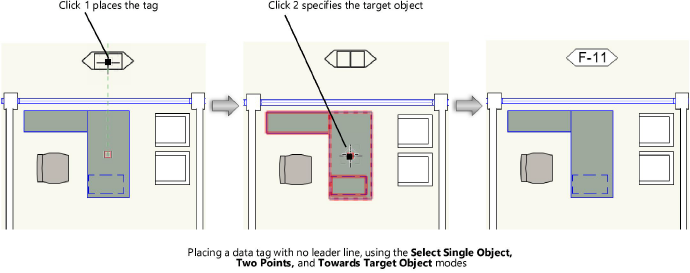 Using data tags
Using data tags Using data tags
Using data tags|
Tool |
Tool set |
|
Data Tag
|
Dims/Notes |
Use the Data Tag tool to add tags that show data associated with drawing objects. This data can be general parameters (such as height), record fields (such as a model number), or IFC data. You can also use the tool to add simple labels that don’t show data from any object, such as a date stamp.
A large number of data tags are provided in the Vectorworks resource libraries. To show different data or tag different types of objects, create a custom tag.
|
|
Click here and here for video tips about this topic (internet access required). |

|
Mode |
Description |
|
Active Tag Def |
Opens the Resource Selector to select a resource for tagging; double-click a resource to activate it |
|
Label |
Places a tag that is not linked to any drawing object |
|
Select Single Object |
When you click on an eligible object, places a tag that is linked to the object |
|
Select Eligible Objects |
Highlights all eligible objects that are selectable in the current layer or in the current viewport’s annotations; click one object to tag them all |
|
Single Point |
If the active tag has no leader, places a tag with one click |
|
Two Points |
If the active tag has no leader, places the tag with two clicks |
|
Towards Target Object |
If the active tag has a leader, or if Two Points mode is selected, the first click places the tag, and the second click specifies the target object |
|
Towards Data Tag |
If the active tag has a leader, or if Two Points mode is selected, the first click specifies the target object, and the second click places the tag |
|
Preferences |
Sets the default parameters that are used for each new data tag object; see Creating data tag styles |
To add tags:
1. Click the tool.
2.Click Active Tag Def on the Tool bar to select a resource from the Resource Selector.
Vectorworks library files that name specific types of objects (such as Wall.vwx) contain tags that are designed to be attached to that type of object and to show specific data from the object. The other files contain tags that do not link to an object; these are used as labels only. When you double-click to activate a Vectorworks library tag, the program creates a resource folder named Data Tag Styles in your file and places the resource there.
To create a custom tag, select an existing tag or tag resource to use as a starting point. Edit the parameters, geometry, and data as described in Creating data tag styles.
3.From the Tool bar, click the desired modes for placing the tag and leader, if applicable.
● If a simple label tag (such as a date stamp) is active, select either Label or Select Single Object mode.
● If an object-specific tag (such as a wall tag) is active, select either Select Single Object or Select Eligible Objects mode.
4.If the active tag is not appropriate for the selected mode or for the available drawing objects, an alert opens (for example, if you selected a door tag, but there are no doors in the current view or layer). Select a different tag or mode, or adjust what can be seen and selected in the current view.
5.Place the tag as follows:
● Label mode: If the tag has no leader, simply click to place the tag. Otherwise, click twice, to place the tag and the end of the leader line separately.
● Select Single Object mode: An eligible object is highlighted when the cursor is over it. If the tag has no leader, and Single Point mode is selected, highlight the object to be tagged, and click to place the tag. Otherwise, click twice, to place the tag and leader line separately.
● Select Eligible Objects mode: All eligible objects are highlighted automatically. Click any one of the objects to tag all of them. If some eligible objects already have the active tag, they are not highlighted and tagged again.

The data tag is placed in the appropriate plane, depending on where the tool is used.
● Viewport in an annotation context: annotation plane
● Design layer in Top/Plan view: layer plane
● Design layer in a 3D view: active plane
~~~~~~~~~~~~~~~~~~~~~~~~~